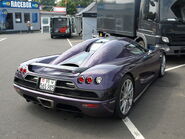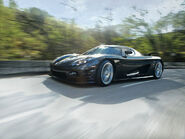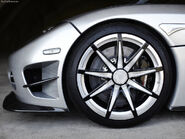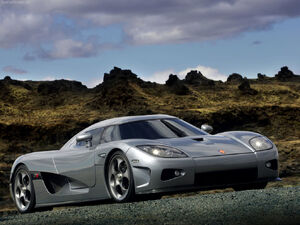
| |
| Koenigsegg CCX | |
|---|---|
| Koenigsegg | |
| aka | |
| Production | 2006 - 2010 |
| Class | Supercar |
| Body Style | Mid-engined 2-door, 2-seat |
| Length | 4293 mm |
| Width | 1996 mm |
| Height | 1120 mm |
| Wheelbase | 2660 mm |
| Weight | 1280 kg |
| Transmission | 6-speed manual, 6-speed automated manual, RWD |
| Engine | 4.7 L V8 (twin s/c gasoline/ethanol 4.8 L V8 (twin s/c gasoline/ethanol) |
| Power | 795 hp (593 kW) @ 7000 rpm 679 lb·ft (920 N·m) @ 5700 rpm |
| Similar | |
| Designer | Sven-Harry Åkesson |
The Koenigsegg CCX was a supercar from the Swedish car manufacturer Koenigsegg, to replace the Koenigsegg CCR. CCX is an abbreviation for Competition Coupe X, the X commemorates the 10th anniversary of the completion and test drive of the first CC vehicle in 1996. The CCX was intended to be suitable for the United States market and thus engineered to comply with US regulations. A base model CCX costs approximately US$ 540 000 (€ 395 000) but with all optional extras the car costs US$600 000 (€440 000).
The CCX was first unveiled on February 28, 2006 at the 2006 Geneva Motor Show although its existence was announced earlier. The CCX was also available as the CCXR, the difference being that CCXR's engine is tuned to run on biofuel. The different fuel and tune allows the CCXR to produce 25% more power than the CCX.
Recent Changes[]
- For 2009, the CCX gets a new infotainment system. [1]
Styles and Major Options[]
Pricing[]
Prices are taken from Koenigsegg's Official Website.[2]
| MODEL Trims | |||
|---|---|---|---|
| base | fully equipped | Trim3 | Trim4 |
| MSRP | |||
| €458,000 ($578,866 or £303,373) | €510,000 ($644,589 or £337,817) | $Price3 | $Price4 |
| Invoice | |||
| $Price1 | $Price2 | $Price3 | $Price4 |
Gas Mileage[]
Add more fields as necessary.
As seen on the FuelEconomy.gov website, the City/Highway MPG averages are as follows:
| Trim | |||
|---|---|---|---|
| Trim1 | Trim2 | Trim3 | Trim4 |
| MPG | |||
| c/h | c/h | c/h | c/h |
Engine and Transmission[]
Engine[]
While the previous Koenigseggs were powered by a V8 Ford Modular engine sourced from the U.S., the engine of the CCX was designed by Koenigsegg based on the Ford Modular engine architecture, and assembled for them by Grainger & Worrall, a British company that produces drivetrain components for Formula One cars. The engine is a 4.7 Litre (4712 cc, 287 cu in) V8, with dual overhead camshafts and 4 valves per cylinder. The engine block is made of 356 Aluminium that has undergone a T7 heat treatment, a form of accelerated precipitation strengthening. The aluminium alloy is stronger than the previous engine and allows a thinner, thus lighter, engine block with higher pressures in the cylinders. The engine is boosted by two centrifugal superchargers that increase the compression to 120 kPa (17.5 psi) with an 8.2:1 compression ratio. The engine produces 601 kilowatts (806 bhp) at 6900 rpm and 920 Newton metres (678 lbf·ft) of torque at 5700 rpm on 91 octane (U.S. rating) petroleum. The engine is lubricated with a dry sump system with a separate oil pump, the pistons are cooled by oil sprayed onto them and the oil itself has an external cooler. The CCX engine burns 17 Litres per 100 kilometres (14 mpg–U.S. / 17 mpg–imp).
Transmission[]
The CCX has a six speed manual gearbox made for Koenigsegg by Cima with a twin plate clutch of diameter 215 millimeters (8.46 in) as default but a sequential manual transmission option is available. The power is fed to the wheels through a torque sensitive, limited slip differential. The option to select gear ratios is available, but the default ratios of the 2007 CCX are in the table.
| Gear | 1 | 2 | 3 | 4 | 5 | 6 | Reverse | Final Drive |
|---|---|---|---|---|---|---|---|---|
| Ratio | 2.875:1 | 1.652:1 | 1.125:1 | 0.865:1 | 0.711:1 | 0.604:1 | 3.000:1 | 3.545:1 |
Performance[]
The CCX can accelerate from stationary to 100 kilometres per hour (62 mph) in 3.2 seconds and 160 kilometres per hour (100 mph) in 7.7 seconds. It can complete a standing quarter mile in 9.9 seconds with an end speed of 235 kilometres per hour (146 mph) and according to Koenigsegg it has a top speed of 395+ kilometres per hour (245+ mph) because it has not officially been tested on a long enough straight to confirm its maximum speed. The CCX has a turning circle of 11 and can turn at 1.3 lateral Gs.
Wheels and brakes[]
The standard CCX wheels are Koenigsegg's magnesium alloy wheels, though the option to upgrade to carbon/magnesium wheels which each weigh 3 kilograms (6.6 lb) less than the standard wheels is available. The front wheels have a diameter of 480 millimetres (19 in) and the rear, 510 millimetres (20 in). Each of the wheels is attached by centre locking wheel nuts. The car comes with Michelin Pilot Sport 2 unidirectional tyres with asymmetric tread. The front tyres have codes of 255/35 Y19 and the rear 335/30 Y20.
The front and rear cast iron disc brakes are 362 millimetres (14 in) across with 32 millimetres (1.25 in) of contact at any point and have 6 piston calipers. The brakes can be upgraded to carbon ceramic brakes which weigh 2 kilograms (4.4 lb) less per wheel, a diameter of 380 millimetres (15 in) with 34 millimetres (1.34 in) of contact and eight piston brake calipers.
Reliability[]
Warranty options and scheduled maintainence information should be mentioned here.
Safety[]
This section should reference points on safety ratings and features of the vehicle.
Photos[]
Colors[]
List the colors that the particular <MODEL> is offered in.
Main Competitors[]
Create links to other <MAKE> <MODEL> pages in this section.
Hybrid Models[]
Koenigsegg made a "green" version of the CCX called the CCXR that runs on E85 biofuel.
Unique Attributes[]
Interior[]
This section should include information on the interior's design, build quality, ergonomics, space (head and legroom, front and rear), features, stowage compartments and overall comfortability and livability. Add pictures wherever applicable and keep information in a third-person point of view.
Resale Values[]
Add more fields as necessary.'
| <MODEL> Year | |||
|---|---|---|---|
| Year X | Year X-2 | Year X-3 | Year X-4 |
| Resale Value | |||
| $ | $ | $ | $ |
Criticisms[]
- "Koenigsegg are saying that the CCX is more comfortable. More comfortable than what - being stabbed?" Jeremy Clarkson, Top Gear
Variants[]
CCXR[]
The CCXR is a more "environmentally friendly" version of the CCX, powered by the same engine, but converted to use E85 and E100 ethanol fuel, as well as standard 98 octane petrol. The CCXR required modified fuel injectors, upgraded fuel lines and piston rings, and a higher boost setting on the superchargers. In standard form, bodywork of the CCXR features heavily optimized aerodynamics, along with optional diffusers to enhance airflow, including an optional front splitter with an aerodynamic nolder. When run on ethanol, the power increases to 1,032 PS (759 kW; 1,018 hp) at 7000 rpm and 1,060 N⋅m (782 lb⋅ft) of torque at 5600 rpm. This is a direct result of the cooling properties of ethanol in the engine's combustion chambers along with the added boost, made possible by ethanol's higher octane rating when compared to gasoline. Due to the lower specific energy content of ethanol, the CCXR burns slightly more fuel than the CCX with a combined fuel consumption of 22 L/100 km (13 mpg‑imp; 11 mpg‑US) under the EU cycle.
In March 2009 the CCXR was chosen by Forbes as one of the ten most beautiful cars in history.
CCX Edition, CCXR Edition, CCXR Special Edition[]

CCXR Edition
At the 2008 Geneva Motor Show, Koenigsegg presented two special edition models, the CCX Edition and the CCXR Edition, both fitted with a remapped, 4.8 L twin-supercharged V8 engine and limited to 2 and 4 units respectively. The modifications to the engine increase the power of the CCX Edition to 900 PS (662 kW; 888 hp) on normal gasoline and 940 N⋅m (693 lb⋅ft) of torque while the CCXR Edition ratings remained unchanged over the CCXR.
The Edition models are more track oriented compared to the standard models, being equipped with stiffer springs and anti-roll bars, new dampers and a lowered chassis, a bare carbon body, unique 11 spoke aluminium wheels with a unique rear wing, and a larger front splitter and side winglets, all of which make the car capable of producing 350 kg (772 lb) of downforce at 250 km/h (155 mph). The interior is also reworked and features; colour matched leather carpets, Koenigsegg Edition side step plates and Edition chronograph instrument cluster. All other extra equipment for the Koenigsegg CCX and CCXR Edition comes as standard which include optional carbon fibre wheels, a rearview camera, Satnav or Bluetooth, amplifiers, and a complete Inconell exhaust system.
Later, Koenigsegg also built 2 CCXR Special Edition cars which when compared to the old CCXR Edition had equipped with the double F1 wing, a revised aero package with a unique and larger front splitter and side winglets, wheel vents on top of the body, as well as Koenigsegg's first F1 Paddleshift system.
CCXR Trevita[]

The CCXR Trevita is a limited edition of the Koenigsegg CCXR featuring a diamond weave carbon fibre finish. Trevita is an abbreviation in Swedish and translates into "three whites". The Koenigsegg Proprietary Diamond Weave, fully developed by Koenigsegg, is a new and unique method to manufacture the carbon fibre used for the CCXR Trevita. By utilising this new and unique method, Koenigsegg managed to coat the fibres with a diamond finish. The fibre treatment is conducted carefully in small quantities, prior to further processing the pre-production material.
Initially, three CCXR Trevitas were planned to be produced, however, because of the complexity to make the special diamond weave carbon-fibre, only 2 were ever made, making it one of the rarest vehicles manufactured by Koenigsegg. Both cars featured the Koenigsegg Shimmering Diamond Weave bodywork, twin-deck carbon fibre rear wing, inconel exhaust system, carbon ceramic brakes with ABS, airbags, F1 paddle-shift gearbox, chrono instrument cluster, infotainment system, tire monitoring system and a hydraulic lifting system. The Trevita is also one of the most expensive sports cars, costing US$4.8 million. One was owned by boxer Floyd Mayweather until it was sold in 2017 for 2.6 million dollars.
Worldwide[]
If this vehicle is sold in other markets worldwide, then this is the section to mention that information. Also, mention if the <MODEL> goes by another name in these other markets.
Design quirks and oddities[]
Top Gear[]
A pre-production CCX was featured on the May 7, 2006 edition of BBC motoring programme Top Gear. It was test-driven by Jeremy Clarkson, who praised the car highly but criticised its lack of downforce, which he attributed to the lack of a rear spoiler. The first Power Lap time was 1:20.4 seconds, with the Stig encountering short-shifting problems. Later in the same edition, the car was crashed whilst the Stig was on his second attempt at the Pagani Zonda F's time; the Stig also went on to suggest that the car would be significantly faster and more stable with a spoiler. Koenigsegg then wrote back and said that they will put a rear spoiler on the car in the near future and promised to return the car back to Top Gear for further testing.
On the May 28, 2006 episode of Top Gear, Koenigsegg supplied a CCX fitted with a rear wing. The Stig had another attempt and the car went on to set what was then a new lap record - 1:17.6 since then it has been beaten by the Ascari A10 & Gumpert Apollo. The carbon-fibre rear wing is available as Optional Equipment, though it drops the car's top speed to 230 mph.
On the same programme, Jeremy Clarkson stated that he had found a thing better than smoking, the Koenigsegg CCX.
Other appearances[]
The Koenigsegg CCX appears in the Collectors Edition of Need for Speed Carbon. In the game, the car's maximum speed is only 202 mph.
One of the first North American drives of the CCX by the automotive press was made by Modified Luxury & Exotics at a showing of the car by Exotic Cars at Caesars Palace, dealership in the forum shops at Caesars that sells high end automobiles and is the exclusive US dealer for Koenigsegg. The reviewer praised the power and design of the CCX, but derided the interior and "feel" of the engine. The CCX at the showing was noted as the same car that The Stig crashed on Top Gear and had notched 3000 track miles.
Awards[]
- 2009 Best Performing Green Exotic, duPont Registry
- One of the 10 Most Beautiful Cars by Forbes magazine
In 2007, the CCX was the fastest car to complete Top Gear's Power Lap with a time of 1:17.6 (until it was beaten by the Ascari A10 with a time of 1:17.3). The car originally lapped the circuit in 1:20.4, but was then fitted with an optional rear wing to provide downforce after the show's test driver (The Stig) spun it off the track. The Stig purportedly recommended this modification, predicting that the car would then be the fastest ever round Top Gear's track but Koenigsegg later stated that the improvement was due to adjustments to the chassis and suspension settings and not the addition of the rear spoiler. Despite this, the Stig's spoiler-idea remained the credited reason for the improved lap time.
See Also[]
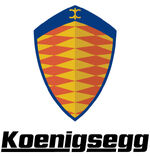
| ||
| KOENIGSEGG | ||
|
Current Historic CC · CC8S · CCR · CCX · CCXR ·Agera · Agera R · One:1 Racing Concept | ||
| Christian von Koenigsegg | Official website | independent |

|
This page uses some content from Wikipedia. The original article was at Koenigsegg CCX. The list of authors can be seen in the page history. As with Autopedia, the text of Wikipedia is available under the GNU Free Documentation License. |


